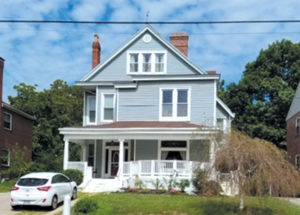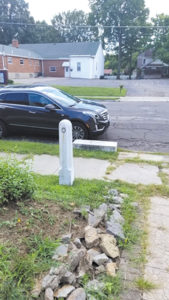 By Sally Gronauer
By Sally Gronauer Our son David and his wife Emily just bought a house in Cincinnati, Ohio. The house was built in 1890. Both were not sure what this cement block in front of the house was. It definitely seemed like more than just a cement block. With a little research they discovered it was a carriage stone. They were originally thinking of removing it but decided it was an important part of the history of their house, so it will stay. We are proud of them for treasuring this modest symbol of hospitality.
What exactly is a carriage stone or step?
A carriage step is a block of stone placed near the edge of the street usually in line with the front doorway of a home, it served as a stepping stone to help passengers as they climbed in and out of carriages. Popular back in the horse and buggy days of the 19th century carriage steps could be seen in towns and cities all over the United States. They are rarely seen in the present day as most carriage steps have been destroyed because they became obsolete when cars took over as primary transportation. These reminders of a seemingly distant past can be found in many parts of the city.
While carriage steps were often found outside the homes of the town’s wealthier residents, they speak to the importance of carriages and stages and means of transportation. Ultimately the arrival of the railroad would make stagecoaches no longer economically viable and automobiles would do the same to carriages. The implements of horse-drawn travel – hitching posts and carriage steps – remain as testimony to their importance in an earlier age.
 Another relative of a carriage step is a mounting block. Mounting blocks were especially useful for women riding sidesaddle or pillion, that is ‘riding double,’ allowing a horse to be mounted without a loss of modesty. They were also used to assist ladies and men into and out of carts. They were frequently located outside churches or kirks for the use of parishioners attending services, funerals, etc. Often they were located on the main streets and outside public houses. Some were built at the top of steep lanes, where the rider would remount after leading his horse up the slope.
Another relative of a carriage step is a mounting block. Mounting blocks were especially useful for women riding sidesaddle or pillion, that is ‘riding double,’ allowing a horse to be mounted without a loss of modesty. They were also used to assist ladies and men into and out of carts. They were frequently located outside churches or kirks for the use of parishioners attending services, funerals, etc. Often they were located on the main streets and outside public houses. Some were built at the top of steep lanes, where the rider would remount after leading his horse up the slope. Mounting blocks were simple stone blocks – often granite – that allowed passengers an easier way of climbing on board a carriage or stagecoach. Carriage steps were a fancier alternative, with two steps often carved into the stone.
Mounting blocks today are primarily used by modern equestrians who are a) beginners b) people who have difficulty mounting (either a tall horse, or because they are a short person, or they are someone with mobility impairments) and c) people who feel that use of a mounting block reduces strain on the horse, particularly at the withers. Modern mounting blocks are usually made of wood or of molded plastic.
A horse is best mounted using a mounting block because it is easier for the rider to mount the horse, it puts less strain on the stirrup leathers when mounting and it decreases the chances of the saddle slipping to one side when mounting, thereby reducing the chances of a fall and possible injury to the rider.















Follow Us